Nestled in the lush, green landscapes of Maharashtra, Pune is a vibrant city that seamlessly blends historical charm with modern dynamism. Often referred to as the “Oxford of the East” due to its renowned educational institutions, Pune stands as a cultural and intellectual hub in India. Its pleasant climate, enriched history, and burgeoning cosmopolitan atmosphere make it a compelling destination for tourists and locals alike.
Pune’s historical significance is showcased through its impressive array of heritage sites, such as the Shaniwarwada Fort and the Aga Khan Palace. The city’s past is vividly interwoven with tales of the Maratha Empire, offering visitors a glimpse into its regal legacy. Meanwhile, Pune’s modern face is characterized by its bustling tech hubs, thriving arts scene, and diverse culinary offerings, creating a city that is both historically rich and forward-looking.
Tourism in Pune is a diverse experience, catering to a wide range of interests. From the serene surroundings of the Osho Ashram and the tranquil lakes like Pashan Lake and Khadakwasla Dam, to the vibrant streets of Koregaon Park and Laxmi Road, there is something for every traveler. Pune’s numerous cultural festivals, like the Ganesh Chaturthi celebrations, add a splash of local color and excitement, making the city an ever-evolving canvas of experiences.
Whether you’re exploring ancient forts, indulging in local delicacies, or simply enjoying the picturesque scenery, Pune promises a memorable journey through its unique blend of tradition and modernity.
Shaniwar Wada Palace

Shaniwar Wada stands as a remarkable example of Maratha Imperial architecture from a bygone era in India. This historic fort bears witness to the events that shaped the lives of the Peshwas and the Maratha Kingdom over time.
Originally built by the Peshwas, Shaniwar Wada symbolizes the courage and determination of the Marathas, who fought tirelessly to preserve its glory. Though the fort has endured the ravages of time, the remaining stone walls continue to tell the untold stories of the heroic Marathas’ colorful journeys.
Even in its current state of ruin, Shaniwar Wada still echoes the remarkable tales of its past. The massive stone boundaries, which were constructed to protect the fort, reflect the level of security once provided to the people of the kingdom.
The walls feature a grand wooden gate, showcasing elements of Mughal architecture. This gate, fortified with long iron spikes, was designed to withstand enemy attacks and deter elephants from breaching the palace’s defenses.
Within the fort’s grounds, you’ll find a garden that mirrors Mughal architectural styles, complete with a charming fountain in the center that resembles a 16-petaled lotus. The garden also features markings on the ground, hinting at the layout of rooms that once stood there.
Although time has taken its toll, reducing the mighty Shaniwar Wada to ruins, these remnants still offer a window into the past. By exploring these remains, visitors can step back in time and relive the history that once unfolded within its walls.
History of Shaniwar Wada
The foundation stone of Shaniwar Wada was laid in 1730 by Peshwa Bajirao I. Initially, it was envisioned as a grand seven-story palace made entirely of stone. However, due to opposition from the people in the national capital, who believed that only a king should have a stone castle, the construction was altered to use bricks instead.
The construction of Shaniwar Wada, which took two years to complete, resulted in a stunning structure that beautifully combined Maratha Imperial and Mughal architectural styles. The interiors were adorned with exquisite furniture, intricate carvings of flowers, and vibrant paintings depicting scenes from the Mahabharata and Ramayana.
However, the fort faced a series of devastating fires over the years. The first major fire occurred in 1791, severely damaging a large portion of the fort, which was later reconstructed. In 1808, another explosion destroyed most of the essential artifacts and documents housed within the palace.
Subsequent fires further ravaged the structure, with one in 1812 reducing the upper two stories to ashes and another in 1813 that destroyed the Royal Hall. The destruction reached a peak in 1818 when the British attacked Shaniwar Wada, causing the collapse of the remaining upper stories. Finally, in 1828, a catastrophic fire engulfed the entire palace, burning for a week and leaving it in ruins.
Architecture of Shaniwar Wada
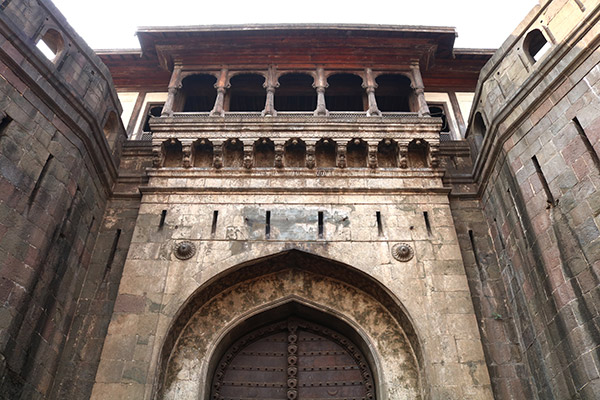
The architecture of Shaniwar Wada is a striking example of Maratha construction style, seamlessly blended with elements of Mughal architecture. The main entrance, known as the Delhi Darwaza, is fortified with iron spikes to fend off enemy attacks. It is large enough for an elephant to pass through and features a small gallery above the door with dome-shaped windows, a clear influence of Mughal design.
In addition to this main gate, Shaniwar Wada has four other gates: Mastani Darwaza, Khidki Darwaza, Ganesh Darwaja, and Narayan Darwaza. The walls of the fort are adorned with intricate floral carvings and paintings that reflect the Mughal architectural style.
Depictions of scenes from the Ramayana and Mahabharata are also found painted in prominent areas throughout the fort. The windows and doors, with their dome-shaped design, further emphasize the Mughal influence. Archaeologists believe that the fort originally had six floors before it was damaged by fire. The garden, featuring a 16-petaled lotus, stands as a symbol of the elegance of the past era.
How to Reach
Shaniwar Wada is located about 12 kilometers from Pune Airport, making it a convenient 15-minute journey to reach this historic palace. The most practical way to travel from the airport to the fort is by hiring a taxi or taking an auto-rickshaw.
Best Time to Visit
The ideal time to visit Shaniwar Wada is between October and February, when the weather is pleasantly cool and comfortable. This period follows the monsoon season, so the garden at the Wada is lush with greenery and vibrant flowers, enhancing your overall experience.
It’s advisable to avoid visiting during the summer and monsoon months, as the weather can be extremely hot and humid in summer, while heavy rains during the monsoon can dampen your outdoor plans. For the best experience, plan your visit early in the morning around 8:00 am when the crowds are thinner and the lighting is perfect for photography.
Other Essential Information
- Location: Shaniwar Peth, Pune, Maharashtra 411030
- Timings: 8:00 am to 5:30 pm
- Entry Fee: INR 5 for Indian tourists, INR 125 for foreign tourists
Shaniwar Wada Light and Sound Show

The Shaniwar Wada Light and Sound Show takes place after sunset, starting at 7:30 pm. The ticket counter opens at 7:00 pm, and it’s advisable to arrive early to avoid the rush. The first show at 7:30 pm is in Marathi, followed by a Hindi version at 8:30 pm.
The show features an impressive display of lights, images, and video projections on a water fountain, narrating the story of Shivaji and the history of Shaniwar Wada. It’s a must-see for anyone interested in learning about the Maratha warriors’ glorious past. However, note that the show may be canceled in case of rain, as it is held in an open area.
Pataleshwar Cave Temple
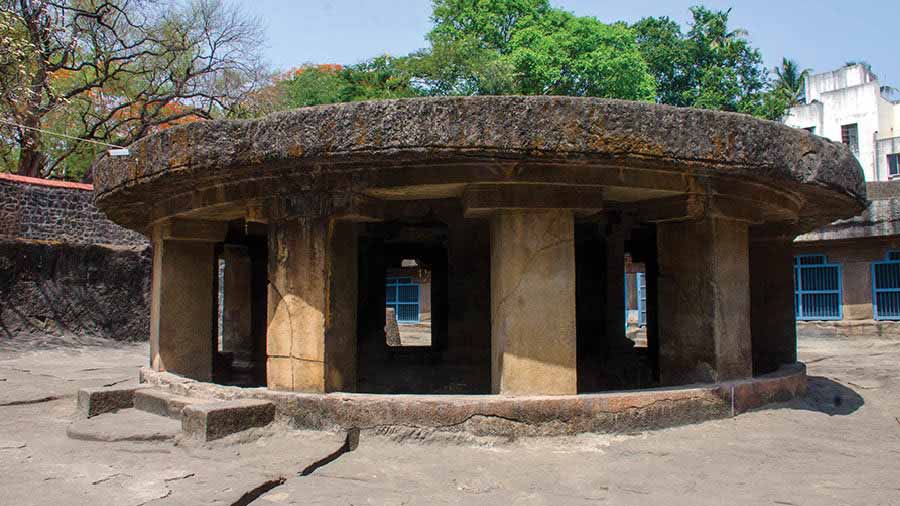
Pataleshwar Cave Temple is a notable historical site in Pune, dedicated to Lord Pataleshwar, the God of the Underworld. This ancient temple, carved from a single rock in the 8th century, is recognized as a protected monument by the government. Renowned for its architectural brilliance and unique sound of bells, the temple offers a fascinating glimpse into India’s rock-cut architecture.
The temple is dedicated to Lord Shiva and Nandi, with the main shrine featuring an imposing Shiva lingam. One intriguing aspect of Pataleshwar Cave Temple is its incomplete construction, resulting in a lack of a defined entrance. Despite this, the temple remains a significant destination for both spiritual visits and appreciation of regional art and culture.
Historical Significance
Constructed in the 8th century, the Pataleshwar Cave Temple stands as a testament to India’s rich history. Carved from a single rock, the temple is dedicated to Lord Pataleshwar, the God of the Underworld. Notable for its detailed inscriptions and architectural marvels, it draws tourists from around the world.
The temple features several intricate carvings and statues, including those of Lord Shiva and Nandi. Despite its grandeur, the construction remains incomplete due to a defect discovered in the rock. This incomplete state has led to various theories about the temple’s history, including possible political instability or shifts in priorities.
Similar in style to the Elephanta Caves near Mumbai, Pataleshwar Cave Temple has also achieved recognition for having 5,000 characters inscribed on a grain of rice.
Architectural Highlights
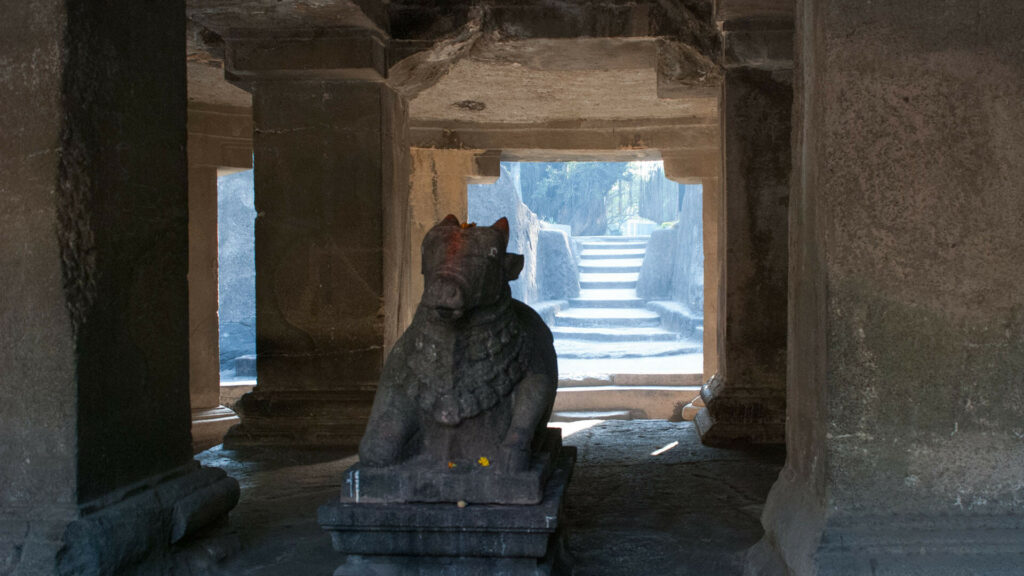
The temple is carved from a single rock, with large pillars supporting its structure. Inside, visitors can find statues of Lord Shiva and Nandi, along with detailed designs and inscriptions. The temple complex includes a spacious sitting area and additional temples dedicated to deities like Lord Ram, Laxman, and Sita. The cave also features several aisles and a mandap, making it a fascinating site for exploration.
How to Reach
- By Air: Arrive at Pune Airport, then take a cab or taxi directly to Pataleshwar Cave Temple. Bus services are also available to Shaniwar Wada, from where local taxis or cabs can be hired.
Best Time to Visit
- Recommended Period: October to March, when the weather is pleasant and conducive for exploring the temple.
Additional Information
- Location: Pataleshwar Cave Temple, Jangali Maharaj Road, Revenue Colony, Shivajinagar, Pune.
- Timings: 8:00 AM to 5:30 PM
- Entry Fee: Free
Aga Khan Palace
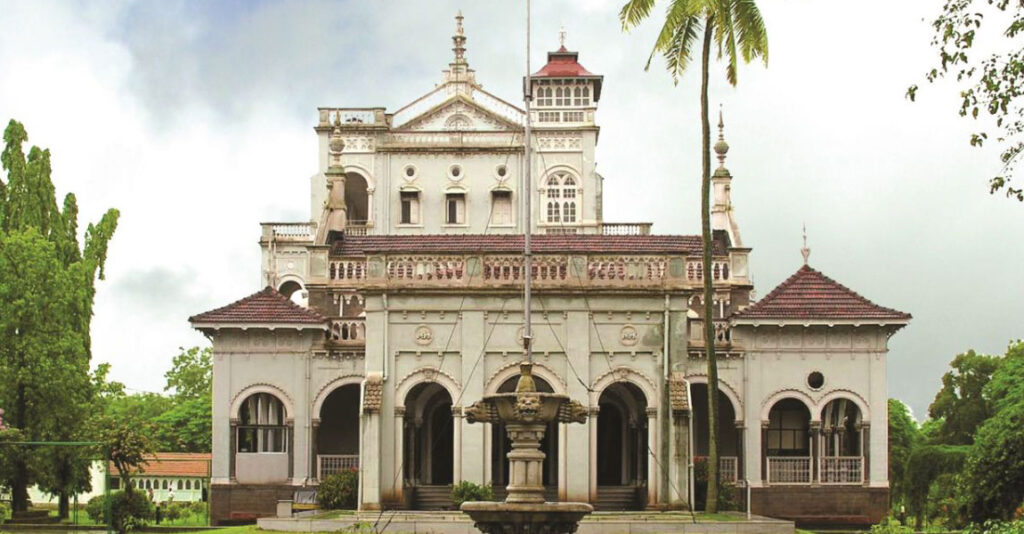
The Aga Khan Palace in Pune is a significant landmark in India’s history, associated with several important events and personalities. It was built in 1892 by Sultan Mohammad Shah Aga Khan III. Notably, this palace was where Mahatma Gandhi and his wife, Kasturba Gandhi, were imprisoned, and today, it is recognized as the Gandhi National Memorial Society. The palace is one of Pune’s major attractions, offering visitors the chance to view Mahatma Gandhi’s personal belongings in the room where he was held.
Set on 19 acres of land in Pune’s Yerwada area, the Aga Khan Palace is a stunning historical monument. Constructed in 1892 by Sultan Muhammed Shah Aga Khan III, the palace is deeply rooted in Indian history, particularly in the context of the Indian freedom struggle. It was originally built to aid the impoverished population around Pune, who were severely affected by a famine in the early 1890s.
The Aga Khan Palace is not only an architectural marvel in Pune but also a popular tourist spot. The palace was designed by the renowned architect Charles Correa and features the samadhis (memorials) of Kasturba Gandhi and Mahatma Gandhi’s secretary, Mahadev Desai, both of whom passed away on the palace grounds. Their memorials are preserved within the palace.
The expansive palace grounds include five luxurious and spacious halls, along with multiple lawns, all reflecting an Italian architectural style that is both elegant and intricate. Among its many features, the palace’s arches are particularly captivating, with their beauty being almost mesmerizing. The structure consists of two large floors and a corridor that spans the entire building.
Throughout the year, the palace hosts various exhibitions and programs, many of which focus on Gandhi’s life, offering visitors a deep insight into his lifestyle and philosophies. Because of its connection to Gandhi, the palace is also known as the Gandhi National Memorial Society. One of the palace’s main attractions is the room where Gandhi stayed during his imprisonment, complete with his personal belongings and photographs of other freedom fighters.
How to Reach
The Aga Khan Palace is approximately 3.7 kilometers from Pune Airport. You can easily reach the palace by taxi, online booking, or by driving yourself, as the route from the airport is straightforward and requires no major turns. Auto-rickshaws and state or private buses departing from the airport can also take you to Nagar Road, where the palace is located. The drive from the airport typically takes between 12 to 20 minutes, depending on traffic conditions.
Best Time to Visit
The ideal time to visit the Aga Khan Palace is from late September or early October through April, when the weather is pleasantly cool and perfect for exploring the historic site. October usually brings clear skies, with occasional light rain that generally doesn’t interfere with outdoor activities.
Summer (March to early June): These are the hottest months, with temperatures reaching up to 40 degrees Celsius, making it less favorable for a visit.
Monsoon (June to September): July is the wettest month, and during this period, the palace gardens can become muddy and slippery, making it challenging to enjoy the outdoor areas.
Winter (December to February): Winter in Pune is cool, with temperatures typically staying below 25 degrees Celsius, offering a comfortable time to explore the palace.
Other Essential Information
- Location: Nagar Road, Samrat Ashok Rd, Pune, Maharashtra 411006
- Entry Fee: INR 5 for Indian Nationals, INR 100 for foreigners, and INR 2 for children.
- Timing: The palace is open daily from 9:00 a.m. to 5:30 p.m.
Sinhagad Fort
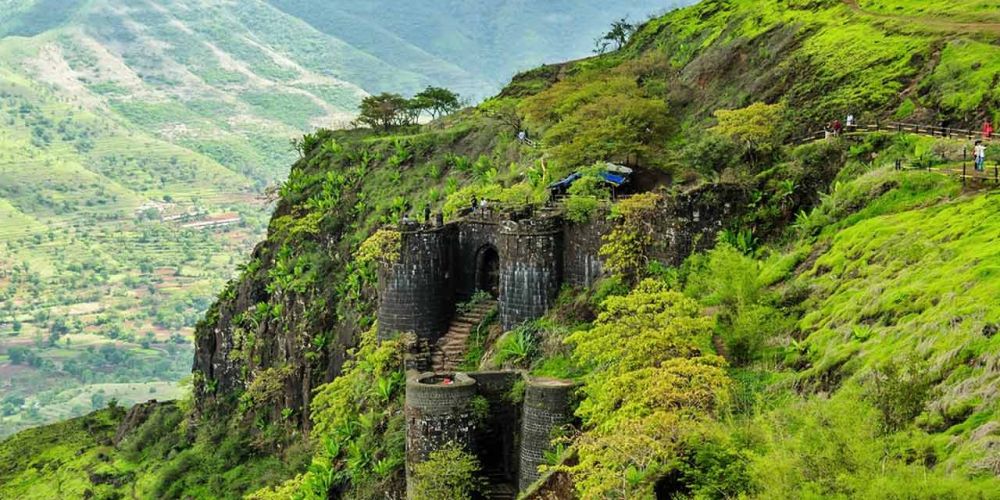
Sinhagad Fort, also known as the Lion Fort, is one of Pune’s most renowned historical landmarks, with a history that dates back roughly 2000 years. The fort, located in the southwestern part of Pune, is said to become more captivating as it ages, especially during the monsoon season, when its beauty is enhanced by the rain. Imagine enjoying a hot cup of coffee with your loved one, surrounded by mist in this magnificent heritage site—truly an experience to cherish.
Sinhagad, formerly known as Kondana, is a symbol of pride for Pune. The fort played a significant role in Maharashtra’s defense during ancient battles, particularly the Sinhagad battle of 1671. Located in the Bhuleshwar range of the Sahyadri Mountains, the fort stands at an elevation of around 1,312 meters above sea level. The steep slopes of Sinhagad served as natural defenses, making it a formidable stronghold.
There are two main entrances to Sinhagad Fort: the Pune Darwaza in the northeast and the Kalyan Darwaza in the southeast. The fort’s authenticity and historical richness, dating back around 1000 years, are evident from the intricate carvings on the walls of the Kaundinya Eshwar temple. Sinhagad Fort is cherished as a significant heritage site for sightseeing.
As you begin exploring the fort, Rajaram’s tomb is a must-visit. The fort also houses remarkable monoliths dedicated to Tanaji Malusare, one of Shivaji Maharaj’s trusted warriors who played a key role in the fort’s history. The fort is also home to military depots, a Kali temple, breweries, and a Hanuman idol. Additionally, the Pune Darwaza, Kalyan Darwaza, Tilak Bungalow, Hawa Point, Kade Lot, Amruteshwar Temple, Tanaji Samadhi, and Memorial contribute to the fort’s enduring elegance.
Climbing to the top of the fort offers breathtaking views, including the Khadakwasla Dam on one side and glimpses of Torna Fort on the other.
How to Reach
The nearest airport to Sinhagad Fort is Pune Airport. From there, you can reach the fort via state-run or private buses, or by hiring a private cab. Here are some alternative travel options:
- By Rail: Pune Railway Station is the closest railway station to Sinhagad Fort. From the station, you can take a private cab or a local bus to reach the fort.
- By Road: The drive from Pune to Sinhagad Fort takes about an hour and 15 minutes. You can hire a private cab, or use services like Uber or Ola to travel between the two points.
- By Bus: Numerous buses operate between Pune and Sinhagad Fort. You can catch a bus from Pune Bus Stand. MSRTC also offers deluxe bus services connecting Pune to Sinhagad. Additionally, state-run buses from MSRTC connect Sinhagad to Mumbai, other parts of Pune, and Nagpur.
Other Essential Information
- Location: Sinhagad Ghat Road, Thoptewadi, Maharashtra 411025.
- Opening Hours: The fort is open daily from 5:00 AM to 6:00 PM.
- Entry Fee: There is no entry fee if you plan to hike up to the fort. However, if you bring a private vehicle, there is a fee of INR 20 for two-wheelers and INR 50 for four-wheelers to reach the top.
- Best Time to Visit: The ideal time to visit Sinhagad Fort is during the monsoon or winter seasons.
- Distance from Pune: The fort is approximately 37.7 kilometers from Pune, requiring about 1 hour and 15 minutes by road.
History of Sinhagad Fort
Originally known as Kondana, Sinhagad Fort has played a crucial role in the Maratha Empire’s history. The carvings on the Kondeshwar temple walls suggest that the fort is over 1000 years old. Until the 14th century, the fort was ruled by a Koli king named Nag Naik. In 1328 AD, it was captured by Muhammad Bin Tughlaq. Later, the administration of Pune, including Sinhagad Fort, was taken over by Shahaji Raje Bhosale.
During this time, Shivaji, Shahaji’s son, vowed to establish swarajya (self-rule). He persuaded Adil Shahi Sardar, Siddhi Ambar, to let him manage and protect the fort. However, Shivaji ultimately seized control of the fort. Adil Shah retaliated by imprisoning Shahaji and Siddh Amber, forcing Shivaji to surrender the fort to secure his father’s release. Seven years later, Shivaji recaptured the fort. Despite facing several attacks by the Mughals between 1662 and 1665, Shivaji maintained control of the fort until 1689. After Sambhaji Maharaj’s death, the Mughals took over the fort.
In 1693, the Marathas reclaimed Sinhagad, but the Mughals regained control in 1703. From 1706 to 1818, the fort remained under Maratha rule until it was eventually captured by the British.
Architecture of Sinhagad Fort
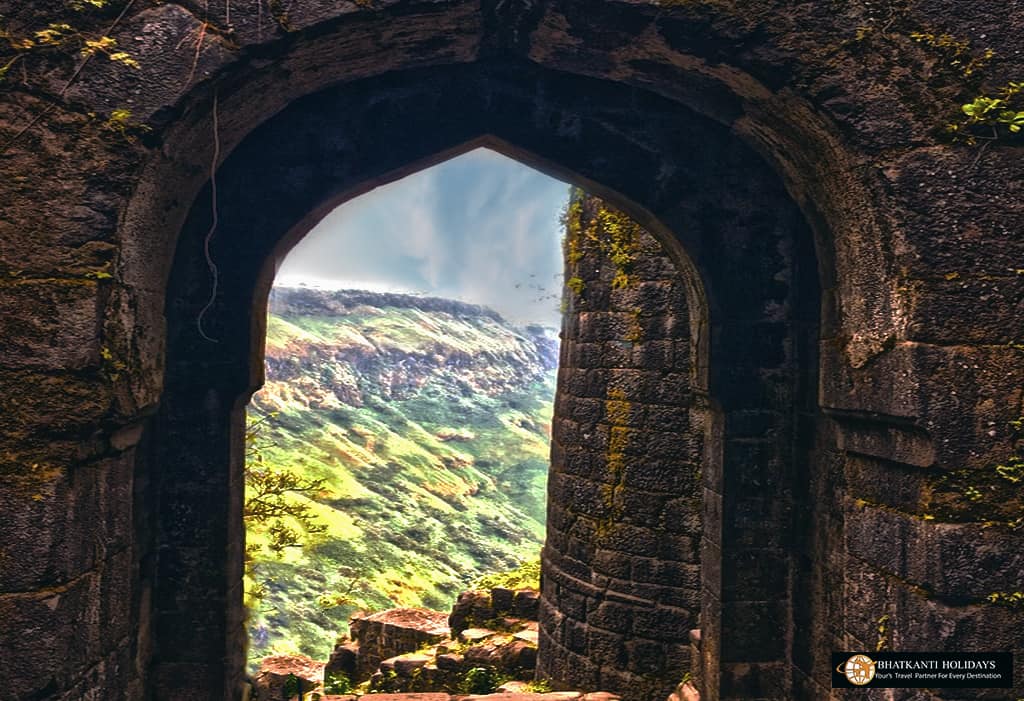
Sinhagad Fort is perched atop a plateau in the Sahyadri Mountains, with steep slopes that provided a natural defense against invaders. The fort is situated at an elevation of 1,300 meters above sea level and rises 750 meters from the mountain’s base.
The ancient stone stairways leading to strategically placed bastions, two entrances, and the surrounding walls are still intact. The two main entrances are the Pune Darwaza in the northeast and the Kalyan Darwaza in the southeast. Inside the fort, you’ll find a Kali temple, military sheds, breweries, Rajaram Raje’s tomb, and Tanaji Malusare’s memorial, which has stood for over 350 years.
Trek Route to Sinhagad Fort, Pune
Night trekking from Katraj to Sinhagad Fort is a popular adventure activity. The trek begins at the Old Katraj Tunnel Top and spans a mountain chain over 16 kilometers. The route offers stunning views of hills and mountain ranges, making it a moderate trek suitable for both beginners and experienced trekkers.
Things to Keep in Mind for a Trek to Sinhagad Fort, Pune
- Trekking to Sinhagad Fort requires physical and mental endurance, but the views and experience are worth it.
- There are no water sources along the trekking route, so carry enough water to stay hydrated during the journey.
- Trekking participants must fill out a form provided by the Adventure Club of Pune.
- If trekking during the monsoon season, ensure your belongings are securely packed to protect them from the rain.
- Wear appropriate trekking gear, including clothing and shoes, to ensure a safe and comfortable trek.
- Activities like rock climbing, rappelling, and other risky adventures are not recommended due to the challenging terrain of Sinhagad Fort.
Osho Ashram
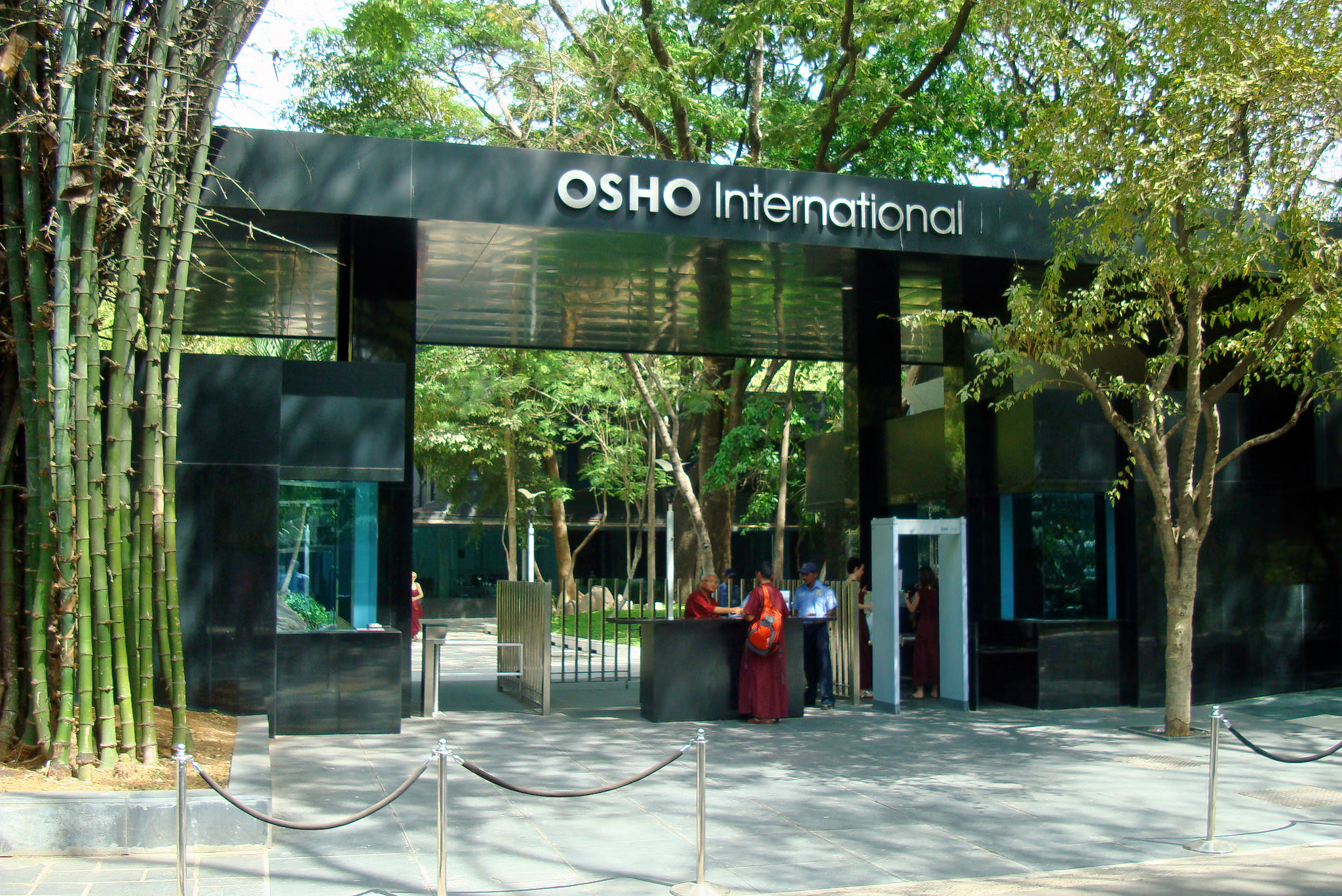
Discover tranquility and rejuvenation at the Osho Ashram in Pune. If you’re searching for a place to escape the stresses of life and connect with your inner self, the Osho Ashram is the perfect destination in Pune. Established by Bhagwan Shree Rajneesh, a well-known spiritual leader and influential public speaker, the ashram is widely recognized as a peaceful retreat. Here, visitors can immerse themselves in a serene environment while enjoying luxurious resort amenities.
The Osho Ashram offers a range of facilities, including a swimming pool, jacuzzi, tennis courts, and a spa, all designed to enhance your experience. Guests can engage in various meditation practices and therapies, ensuring a fulfilling and enriching stay. The ashram provides a host of activities to keep visitors engaged, making it an ideal spot for those seeking to channel their inner energies and find deeper meaning in life.
- Location: 17, Koregaon Park Road, Koregaon Park, Pune, Maharashtra
- Best Time to Visit: The ashram is open year-round, so you can plan your visit at any time.
- Entry Fee: The entry fee for the Osho Ashram is INR 870 per person for a day.
- Timings: The recommended time to visit the Osho Ashram is from 6:00 am to 10:30 pm.
Whether you’re looking to unwind, engage in self-discovery, or simply enjoy a peaceful retreat, the Osho Ashram in Pune offers an extraordinary opportunity to do so in a tranquil setting.
Lal Mahal
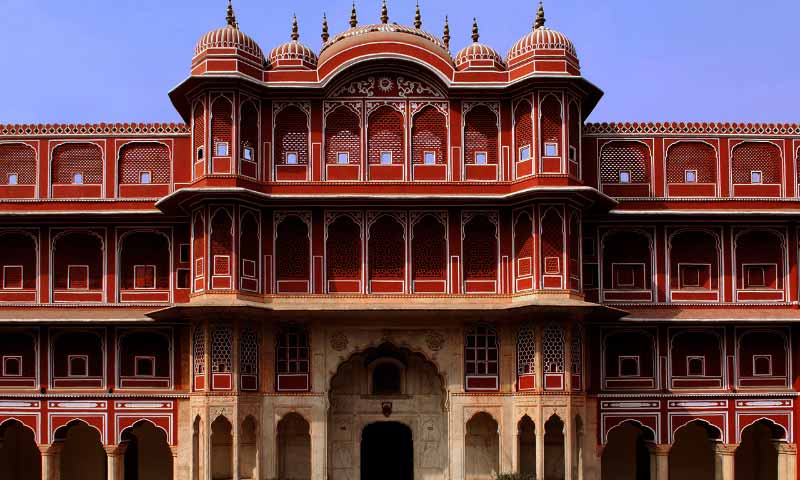
The Lal Mahal in Pune, a striking red palace, is a must-visit landmark for anyone exploring the city. Originally constructed by Shivaji Maharaj’s father, Shahaji Bhosale, in 1630 CE, it was intended to revive Pune, which had recently been ravaged. However, the original structure was destroyed over time, and what stands today is only a portion of the original Lal Mahal.
The current Lal Mahal, rebuilt near Shaniwar Wada, features a collection of oil paintings depicting significant events from Shivaji Maharaj’s life. It also houses a statue of his mother, Jijamata, and offers a popular recreational spot for children at Jijamata Garden. Historically, the Lal Mahal is renowned for the incident where Shivaji Maharaj famously cut off the fingers of Mughal invader Shaistekhan during his escape attempt from the palace.
Situated near Shaniwar Wada, Lal Mahal is a historical symbol of Pune. Dating back to the 16th century, it celebrates the valor of Shivaji Maharaj and his era. The palace is a testament to the heroism of the Peshwas and reflects significant events and strategic planning from Shivaji Maharaj’s time.
The term “Lal Mahal” translates to “Red Palace,” named for its red brick walls, which vividly depict Shivaji’s journey. Inside, you’ll find a depiction of Shivaji Maharaj using a golden plow, an image cherished by his mother and guru. The Mahal also features a small replica of the Raigad Fort.
Despite suffering from attacks that led to its destruction, the present structure, reconstructed by Pune Municipal Corporation in 1998, includes the Jijamata Gardens where many enjoy spending time.
History of Lal Mahal
Shahaji Maharaj, Shivaji’s father, built the Lal Mahal to revitalize Pune, then under the Bijapur Sultanate. Completed in 1630 AD, it served as his residence until 1645. The Mahal witnessed the upbringing of Shivaji Maharaj and, in 1663, became the site of his dramatic battle against Shaista Khan, during which he famously severed the invader’s fingers.
Today’s Lal Mahal, a reconstruction on the site of the original palace’s ruins, contrasts with its predecessor, reflecting the work done by Pune Municipal Corporation.
How to Reach
By Rail: Arrive at Pune Railway Station and take local transport to Lal Mahal, which is 2 km away.
By Road: Lal Mahal is accessible by local rickshaws, taxis, or public buses, all of which have frequent service.
By Bus: Local buses connect Lal Mahal with various parts of Pune.
Additional Information:
Location: Shivaji Road, Kasba Peth, Pune.
Opening Hours: Open daily except Wednesdays, from 9:00 AM to 1:00 PM and 4:00 PM to 8:00 PM.
Entry Fee: 3 INR or 0.046 USD per person.
Best Time to Visit: Open year-round.
Average Temperature: Around 25°C.
Distance from Pune: Located 450 meters from Pune’s center, about a 2-minute drive via Mote Mangal Karyalay Road and Chhatrapati Shivaji Maharaj Road.
Dagdusheth Halwai Temple
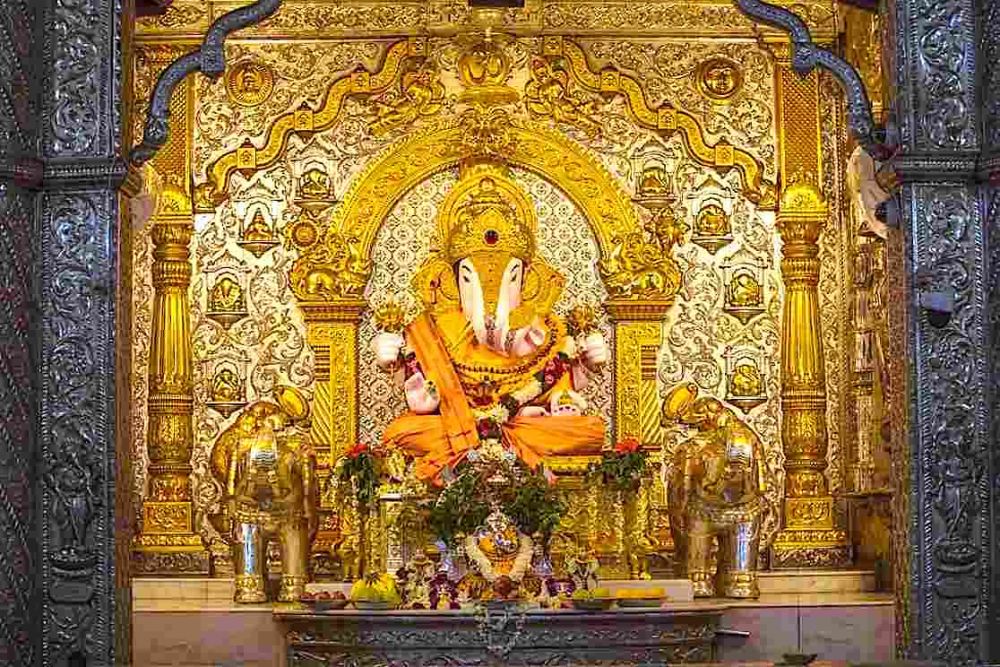
The Dagdusheth Halwai Temple, dedicated to the Hindu deity Ganesha, is one of Pune’s most revered spiritual landmarks. As one of the oldest Ganesh temples in India, it was established by Shri Dagdusheth, a local sweetmaker (halwai). His devotion led to the creation of the temple and inspired his friend, Lokmanya Tilak, to popularize the Ganesh festival, which has since become a significant cultural event in India.
The temple’s modest architectural style is steeped in history and cultural significance. Situated in the heart of Pune, the Dagdusheth Halwai Temple is a central spot for various religious and cultural activities, including music concerts, bhajans (devotional songs), and recitations of the Atharvasheersh.
Location: Shivaji Road, Budhwar Peth, Pune, Maharashtra
Best Time to Visit: The ideal time to visit is from August to September.
Entry Fee: No charge for entry.
Timings: Open daily from 6:00 AM to 11:00 PM.
Pune Okayama Friendship Garden
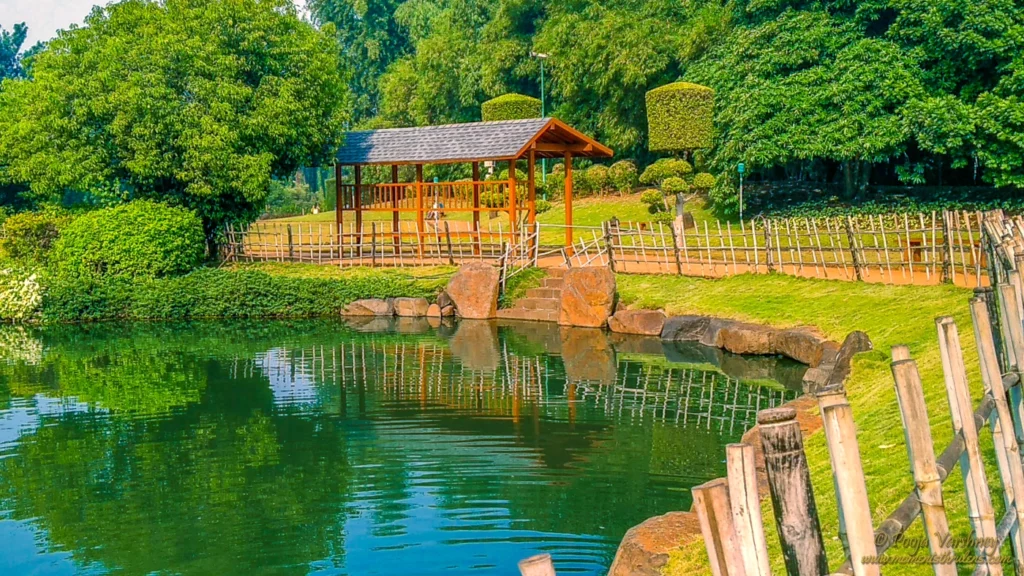
Nestled away from Pune’s bustling city life, the Pune Okayama Friendship Garden is a tranquil oasis that immerses visitors in lush greenery and serene landscapes. Spanning 10 acres, this garden is modeled after the 300-year-old Korakuen Garden in Okayama, Japan, developed by the Ikeda Royal Family. As the largest Japanese garden outside Japan, it has gained popularity and is even featured in various Bollywood films. The garden is also affectionately known as Pu. La. Deshpande Garden, honoring the esteemed Marathi writer Pu. La. Deshpande.
The garden embodies the Japanese philosophy of “Yin and Yang,” representing the balance between light and dark, stillness and motion, and other complementary elements. This ideology is reflected in the garden’s design, which integrates natural elements such as fire, harmony, and water, aligning with the Japanese belief in gardens as spiritual spaces for meditation and self-reflection.
The Pune Okayama Friendship Garden offers a rejuvenating experience with its verdant lawns and calming atmosphere, perfect for revitalizing one’s senses and achieving inner peace. Visitors can enjoy the picturesque landscapes, which include a canal teeming with colorful koi fish and a charming moon bridge that provides an excellent vantage point to observe these vibrant fish.
Within the garden, you’ll find a variety of features including a waterfall, a pond, decorative lanterns, artificial hillocks, and a forested area. The diverse landscape shifts as you stroll along the peaceful pathways, where the sounds of a babbling stream and chirping birds enhance the experience. Pergolas scattered throughout the garden offer serene spots to relax and savor the tranquil environment.
How to Reach
You can reach the Pune Okayama Friendship Garden via state government buses, which run frequently between Pune airport and the garden, with fares ranging from INR 19 to INR 50. Alternatively, taxis are available at the airport, with fares typically between INR 300 and INR 450.
Best Time to Visit
The optimal time to visit the garden is from October to March when the weather is cooler. The garden is open in the mornings and early evenings, allowing you to enjoy the natural beauty and pleasant weather during these hours.
Additional Information
- Location: Sinhgad Road, Dattawadi, Pune, Maharashtra
- Timings: Daily from 6:30 AM to 10:30 AM and 4:00 PM to 8:00 PM
- Entry Fee: INR 5 for adults and children over 3 years. Children under 3 enter for free.
Significance
The Pune Okayama Friendship Garden symbolizes the bond between Pune, India, and Okayama, Japan. It offers a glimpse into Japanese gardening techniques, culture, and traditions. The garden’s design incorporates elements from Shinto, Buddhist, and Taoist philosophies, providing visitors with insights into Japanese spiritual values.
Featuring species like Japanese Camellias, including Tsubaki and Sazanka, the garden is a true representation of traditional Japanese gardens. It includes essential elements like stone lanterns, statues, water basins, koi fish, and a classic Japanese moon bridge. The garden reflects the Japanese philosophy of Yin and Yang, creating a spiritual and balanced environment.
Architecture and Layout
Covering 10 acres, the garden is designed based on traditional Japanese gardening principles. It adheres to the “Sumi” design philosophy, focusing on balance between proportions and spaces. Water features prominently in the garden, with a natural canal inhabited by koi fish and a central bridge offering beautiful views.
The garden includes hills and ponds that represent formal (shin) architectural styles, and peasant huts and mountain retreats that illustrate informal (so) styles. It also features artificial mountains made from ceramic, wood, or irregular stones. Visitors can explore diverse landscapes along long walking paths and relax at pagoda-style resting spots scattered throughout the garden.
Rules and Regulations
- Walking on the lawns is prohibited.
- Outside food is not allowed, but food stalls are available within the garden.
- Maintain cleanliness and avoid littering.
- Keep the washrooms tidy.
- Photography is permitted with prior permission.
Tips for Visiting
- Plan your visit during the garden’s operating hours: 6:30 AM – 10:30 AM and 4:00 PM – 8:00 PM. The garden is closed between 10:30 AM and 4:00 PM.
- If visiting with children, be sure to explore the children’s play area.
- Consider booking a guided tour to learn more about the garden’s history and biodiversity.
- Paid parking is available outside the garden.
- During summer, bring sun protection such as hats, umbrellas, and sunscreen to shield yourself from the sun.
Vetal Tekdi
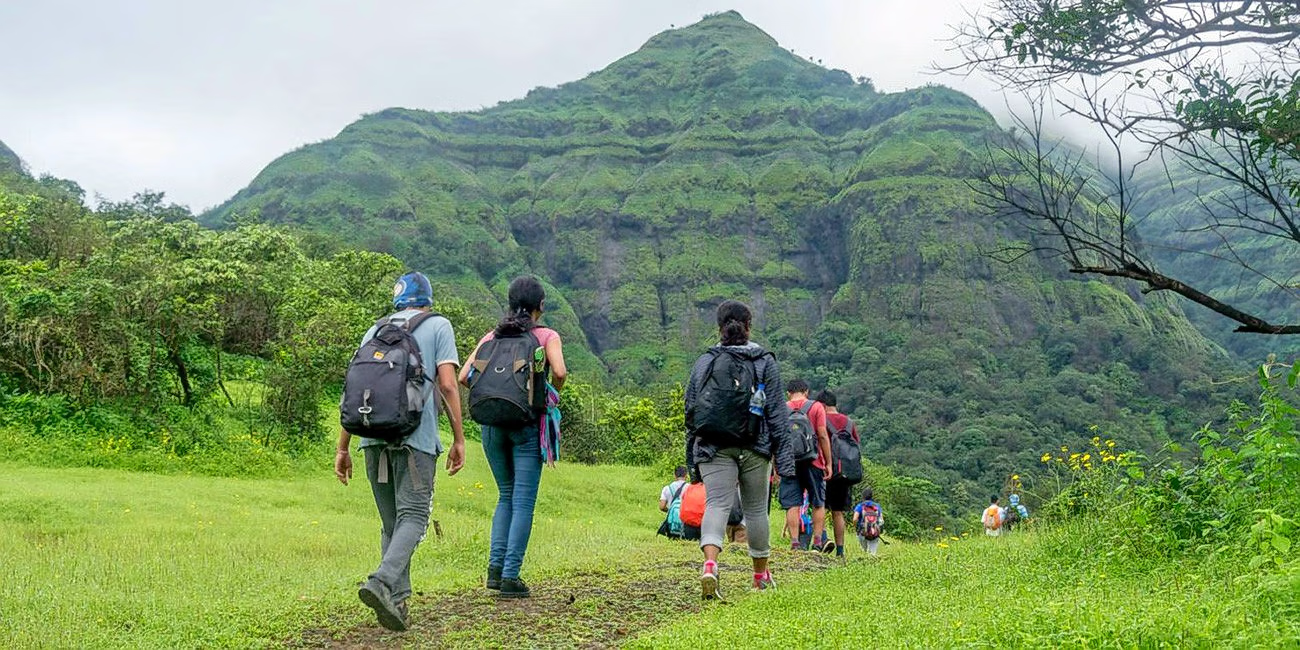
Vetal Hill, locally known as Vetal Tekdi, is a beloved destination for residents of Pune. It’s a popular spot for fitness enthusiasts who visit regularly for early morning walks, jogs, hikes, or cycling. Located about 10 kilometers from Pune railway station, Vetal Hill is easily reachable by road. Standing at an elevation of 2,600 feet, it ranks among the highest points in Maharashtra, making it an ideal location for a family picnic, photography, bird-watching, or a leisurely outing with friends over the weekend.
At the summit of Vetal Hill, forest officials have constructed an observation deck that offers a stunning panoramic view of the natural surroundings. The area is known for its rich biodiversity, including various flora and fauna, small lakes, vibrant birds, and lush greenery in multiple shades. The hill is home to a range of wildlife, such as peacocks, rabbits, falcons, and colorful butterflies.
In addition to its natural beauty, Vetal Hill hosts the famous Vetal Temple and the Chaturshringi Temple. Visitors often climb nearly 100 steps to reach the Chaturshringi Temple, dedicated to the goddess Chaturshringi, among other deities. Bird watchers frequent this area to spot a variety of colorful bird species, including robins, francolins, minivets, and bulbuls.
For those interested in trekking, an early morning hike to Vetal Hill is highly recommended to catch the spectacular sunrise. The hill’s name is derived from the Vetala Temple at its peak, which is dedicated to the goddess Vetala.
How to Reach
- By Rail: The nearest railway station to Vetal Hill is Pune Station. From there, you can take a bus to Vetal Hill, which is about 10 kilometers away.
- By Road: Vetal Hill is located on Pashan Road within Pune city limits. You can reach it by car from either the Panchavati side or Kothrud side. The Paud route is recommended for those driving, as there is a parking area available.
- By Bus: Several buses travel to Pune. You can alight at Pashan and then hike up the hill from there.
Best Time to Visit
Vetal Hill can be visited throughout the year. However, nature enthusiasts often prefer the monsoon season, from July to November, when the greenery is at its most vibrant and the natural surroundings are particularly lush.
Additional Information
- Location: Pashan, Pune 411038, Maharashtra, India.
- Height: 2,600 feet in the Western Ghats.
- Average Temperature: The climate at Vetal Hill is generally pleasant, ranging between 19°C and 25°C.
- Distance from Pune: Approximately 8 kilometers from Pune, taking around 30 minutes to reach by road.
Transportation: Vetal Hill is conveniently accessible by road, and there is ample parking near the hill. Visitors can park their vehicles and walk up the trail, enjoying the scenic beauty of the lush green environment, lakes, and panoramic views along the way.
Rajiv Gandhi Zoological Park
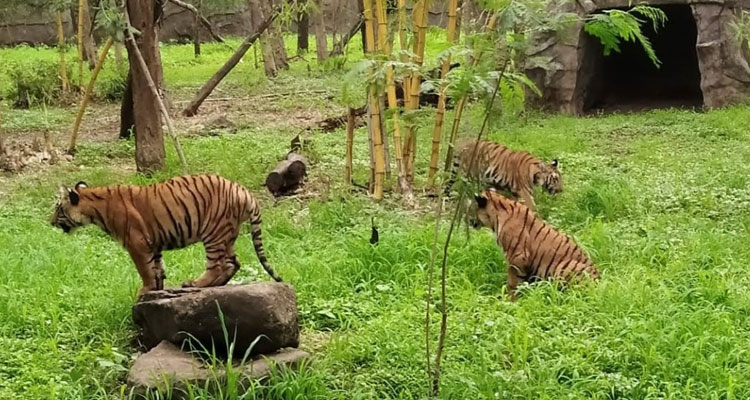
For a delightful day out with family and friends in Pune, the Rajiv Gandhi Zoological Park is a must-visit destination. This renowned park features a range of attractions, including a dedicated snake park, an animal orphanage, and a well-maintained zoo. It’s an ideal spot for wildlife enthusiasts and nature lovers of all ages.
The park offers a unique opportunity to learn about a variety of reptiles and other animals. Highlights include encounters with exotic species such as white tigers, leopards, blackbucks, elephants, and sambhars. Notably, the snake park within the zoo is home to a 13-foot cobra, which is a major draw for visitors interested in reptiles.
Location: Satara Road, Near Bharati Vidyapeeth, Katraj, Pune, Maharashtra.
Best Time to Visit: The Rajiv Gandhi Zoological Park can be visited year-round, as it is open throughout the year.
Entry Fee: The entry fee is INR 15 (approximately USD 0.23) for adults and INR 5 (about USD 0.07) for children.
Parvati Hill

Parvati Hill is a notable landmark in Pune, Maharashtra, renowned for its picturesque views and historical significance. Standing at 640 meters above sea level, this hill offers breathtaking vistas of the surrounding valley and city. Its historical roots extend back approximately 250 years, making it one of Pune’s oldest and most significant sites.
The Parvati Hill Temple Complex, established in the mid-17th century, is situated at the summit of the hill. This revered site features temples dedicated to Lord Ganesha, Goddess Parvati, Lord Vishnu, Lord Karthikeya, and Devateshwar. Historically, it served as a key place of worship for the Peshwa rulers.
To reach the top, visitors must ascend 103 stone steps, which are adorned with distinctive Maratha architectural details. The climb is rewarded with stunning views of Pune and its surroundings.
In addition to the temple complex, Parvati Hill hosts the Parvati Museum, which displays a collection of ancient manuscripts, rare weapons, and unique coins. Nearby attractions include the Sati Monument and Vetal Chabutra. The museum also houses the Samadhi Sthan of Shrimant Nanasaheb Peshwa.
Parvati Hill remains a significant cultural and historical site, offering insight into the Peshwa era. Legends suggest that Balaji Bajirao, a Peshwa ruler, observed the Battle of Kirkee and the British defeat from this very hill.
How to Reach
From the Airport: The nearest airport to Parvati Hill is Pune International Airport, located about 16.8 kilometers away. From the airport, you can travel to Swargate Bus Station by car, bus, or taxi. From there, auto rickshaws can take you to the base of the hill.
Best Time to Visit: Parvati Hill can be visited throughout the year, but the best time is from August to February. During these months, the weather is pleasant, with cooler temperatures and a gentle breeze.
Other Essential Information
Location: Swargate Bus Station, Parvati Paytha, Pune, Maharashtra 411009.
Interesting Facts
- Parvati Hill’s summit, at 640 meters above sea level, housed the Parvati Temple Complex, which was used by the Peshwas for surveillance of their enemies.
- The Peshwa Museum, near the temple, features preserved artifacts from Maratha life, including ancient manuscripts, inscriptions, and 17th-century coins and weapons.
- The hill is historically significant as the vantage point from which Balaji Bajirao watched the British defeat during the Battle of Kirkee.
- Legends tell of Kashibai, mother of Shrimant Nanasaheb Peshwa, who vowed to build a temple at Parvati Hill after her recovery from a foot ailment. Nanasaheb fulfilled this vow by constructing the Parvati Temple.
- Another legend involves the Devdeveshwar Temple, which was established by Nanasaheb Peshwa to honor Chhatrapati Shahu Maharaj. The Shiva Linga here was believed to have originated from the Gandaki River in Nepal but was stolen in 1932.
History of Parvati Hill
Parvati Hill has a rich history dating back to the 17th century. During Shivaji Maharaj’s reign, the hill was granted to Priest Mahadbhat for maintaining its shrines. The main temple was built in 1749 by Shrimant Peshwa III Nana Saheb, fulfilling a vow made by his mother Kashibai. The hill also played a significant role during the Maratha rule, serving as a strategic lookout.
Vishrambaug Wada
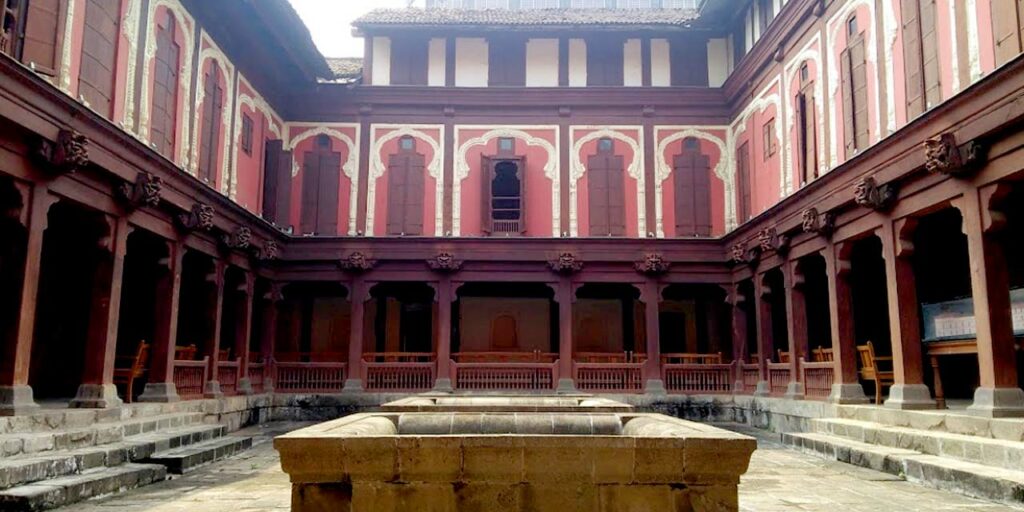
Vishrambaug Wada stands as a significant testament to Pune’s rich cultural history. Constructed in 1807, this grand mansion was originally built for Peshwa Bajirao. The architecture of Vishrambaug Wada is notable for its elegant cypress-shaped columns, intricately decorated ceilings, and commanding verandahs.
Visitors can experience the charm of this historical site through a heritage walk organized every Sunday, which features a lively musical performance for the public.
This landmark not only reflects the grandeur of the Peshwa era but also offers a unique insight into Pune’s past. Currently, the site is undergoing renovations and houses a post office as well as several offices of the Pune Municipal Corporation.
Location: RB Kumthekar Rd, Perugate, Sadashiv Peth, Pune, Maharashtra
Best Time to Visit: The site is accessible throughout the year.
Entry Fee: INR 5 / USD 0.07 per person
Timings: Open daily from 10:00 am to 5:00 pm
Saras Baug
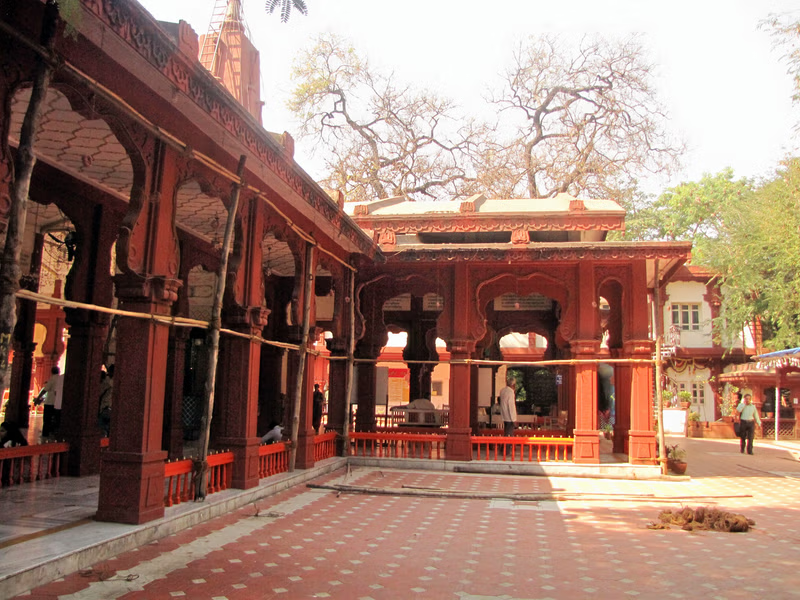
Saras Baug is one of Pune’s most charming destinations, perfect for a day out with family and friends. This scenic 25-acre park is renowned for its lush greenery and the revered Talyatla Ganpati temple. Dedicated to Lord Ganesha, the temple draws many devotees who come to offer their prayers and seek blessings.
The park is an ideal spot for families, especially those with children, and offers a serene environment for picnicking. At Saras Baug, visitors can enjoy a variety of rides, including a giant wheel, making it a fun place for all ages. Food enthusiasts will also appreciate the numerous street food stalls around the park, offering delicious treats such as pav bhaji, bhelpuri, and panipuri.
Location: Saras Baug is conveniently situated about one kilometer from Swargate bus station and 3.6 kilometers from Pune Railway Station.
Best Time to Visit: The park is enjoyable throughout the year.
Entry Fee: There is no entry fee for visiting Saras Baug.
Timings: The park is open daily from 9:00 am to 6:00 pm.
Shinde Chhatri
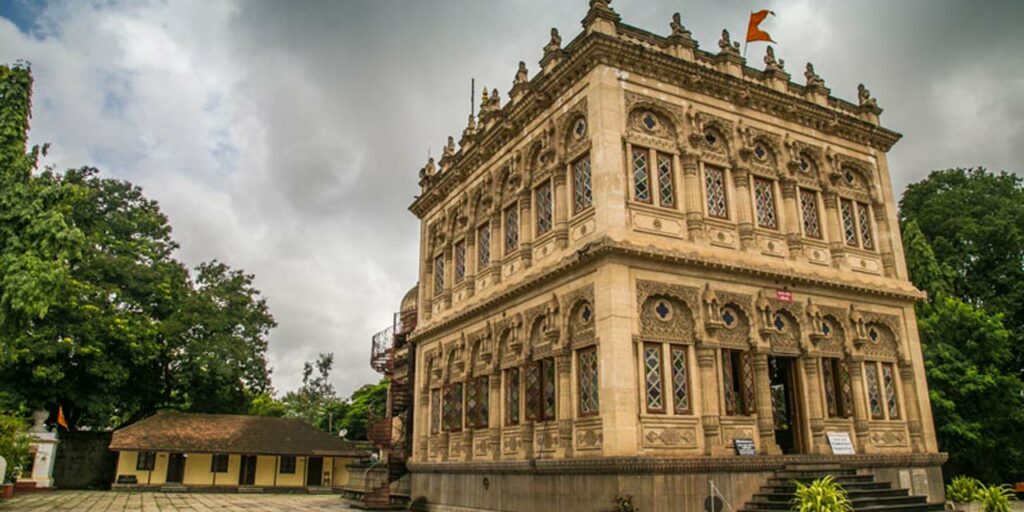
Shinde Chhatri is a prominent historical site in Pune, dedicated to the esteemed Maratha leader Mahadji Shinde. As a significant symbol of the Maratha era in Indian history, it stands as a noteworthy landmark. The site features a memorial honoring Shinde and includes a temple dedicated to Lord Shiva, constructed by Shinde himself.
The architecture of Shinde Chhatri is remarkable, showcasing a blend of Rajasthani and Anglo styles with intricate carvings. This unique design has endured over time and remains one of Pune’s most exquisite architectural feats. Built according to Vaastu Shastra principles, the structure exemplifies a harmonious fusion of two distinct cultural influences. Currently managed by the Shinde Devasthan Trust from Gwalior, Shinde Chhatri attracts numerous art and history enthusiasts.
Location: Shinde Chhatri is situated in Wanawadi, Pune.
Best Time to Visit: The optimal months for visiting are from July to February.
Entry Fee: The entry fee is INR 5 (approximately USD 0.07).
Timings: The site is open from 6:00 am to 9:00 pm.
Panshet Dam
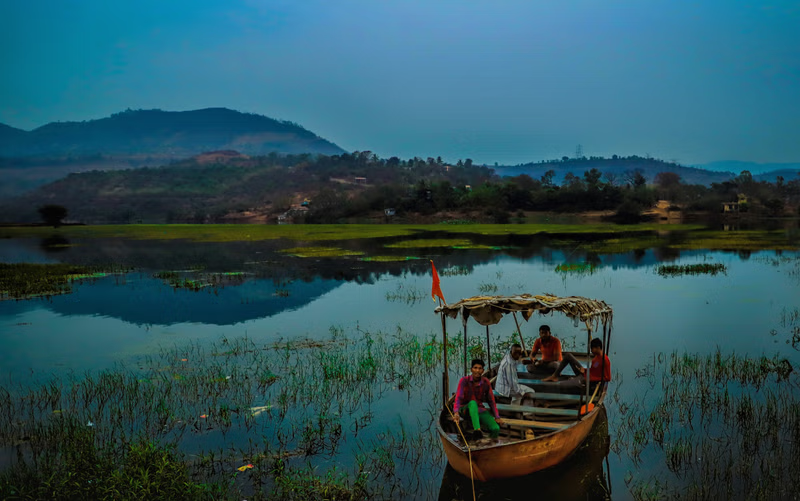
Also known as Tanaji Sagar Dam, Panshet Dam is a top destination for adventure seekers near Pune. Located in the picturesque Sahyadri Ranges, this dam offers a breathtaking landscape and a tranquil escape from city life. Surrounded by lush hills and cascading waterfalls, Panshet Dam is a haven for nature enthusiasts.
Built in the late 1950s, Panshet Dam is situated about 50 km southwest of Pune. With a length of 1039 meters and a height of 63.56 meters, it serves as a scenic retreat away from urban heat and pollution. The area around the dam is dotted with numerous small and large waterfalls, adding to its charm.
Visitors can indulge in various water activities, including banana boat rides, pedal boating, motor boating, water scooters, and kayaking. The verdant hills surrounding the dam offer exciting adventures like hiking, trekking, and rock climbing. For larger groups, bonfire and camping options are available.
The dam also features a children’s play area with swings and slides, making it a great spot for family outings. A small restaurant nearby provides a convenient place for a family meal. Many visitors bring homemade food and mats to enjoy a picnic by the dam. If time allows, you might even join them for a communal experience.
Highlights
- Enjoy the stunning views around Panshet Dam.
- Spend a relaxing day with family by the lake.
- Take a romantic boat ride on the picturesque Panshet Lake.
- Let the kids play in the dedicated playground.
- Trek through the scenic Sahyadri hills surrounding the dam.
- Gather around a bonfire with a barbecue by the lake.
How to Reach
- Distance from Pune: Panshet Dam is approximately 40.7 km from Pune. Via Sinhagad Road, it takes about 1 hour and 30 minutes to reach.
- By Rail: The nearest railway station is Pune (40 km), well-connected to major cities in India. From there, state-run buses are a convenient option to reach the dam.
- By Road: Hire a cab or use services like Ola and Uber for a ride from Pune to Panshet Dam. Travel via Kothrud Road (Rajaram Bridge route), turning right, then follow the road to Khadakwasla, and turn right after Donje Phata. Alternatively, take the Warje Malwadi Route (Uttam Nagar) to Khadakwasla Dam, turn left, and continue towards Donje Phata, then right to reach the dam.
- By Bus: State-run buses operate between Swargate and Panshet Dam.
Best Time to Visit: The ideal times to visit Panshet Dam are during the monsoon season or early winter. During these periods, the waterfalls are full, and the surrounding greenery is lush. In contrast, the waterfalls may dry up during the summer months due to the lack of rainfall.
Taljai Hills

Maharashtra offers a wealth of stunning travel destinations that captivate nature lovers and adventure seekers alike. From lush hills to dense forests, the monsoon season enhances their allure, bringing a fresh, green vibrancy to these locations.
Taljai Hills, a favored weekend retreat in Pune, is renowned for its natural beauty and diverse wildlife. Nestled in the Western Ghats and enjoying a pleasant climate year-round, Taljai Hills is a haven for nature enthusiasts and photographers. The open forest area is ideal for peaceful morning and evening walks.
One of the highlights of Taljai Hills is the revered Taljai Mata Devi Temple situated at the summit. Reaching the temple involves a winding, bituminous trail through the forest, as vehicles cannot access the top. The relatively open forest allows for easy exploration on the hike up.
Visitors may encounter a variety of migratory birds, rare butterflies, peacocks, and rabbits in their natural habitat. The temple area is well-maintained, with paved seating for travelers to relax. Along the way to the Taljai Mata Temple, a charming pond with ducks adds to the picturesque setting.
Taljai Hills is an excellent location for outdoor picnics and excursions, offering a chance to connect with nature and unwind. From the temple’s vantage point, visitors can enjoy a panoramic 360-degree view of Pune city framed by the verdant Western Ghats.
In conclusion, Pune’s diverse array of attractions offers something for every type of traveler, making it a must-visit destination in Maharashtra. Whether you’re captivated by historical landmarks like the Shaniwarwada Fort, seeking spiritual solace at the Osho Ashram, or exploring the serene natural beauty of places like the Pashan Lake and Khadakwasla Dam, Pune has a rich tapestry of experiences to offer. The city’s blend of cultural heritage, vibrant festivals, and modern conveniences ensures a fulfilling visit for all. By immersing yourself in Pune’s dynamic environment and exploring its varied attractions, you’ll gain a deeper appreciation of this multifaceted city and its unique charm. So pack your bags and set out to discover the enchanting sights of Pune—you’re sure to create lasting memories in this captivating corner of India. If you are based in Pune and looking to open a demat account, then you can call at: 9830121215.



